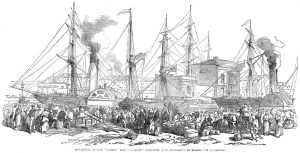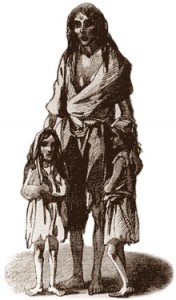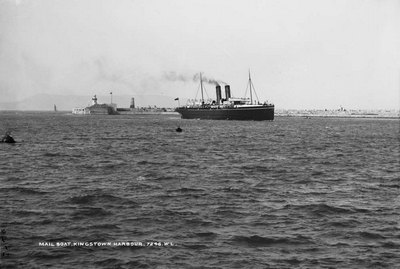Invisible Income – Remittances from the Diaspora sustained Ireland for over a century

By Evan Comerford
When interviewed by the Irish Folklore Commission in 1955, an elderly Galway farmer recalled vividly the neighbours from his youth that lived on a tiny farm consisting of poor bogland next to his own home.
They had ten children, seven of whom emigrated to the United States and regularly sent money back home to Galway. Eventually, the family at home were able to use the money to purchase a better farm nearby and send the youngest son into the priesthood.[1]
Such familiar anecdotes about the unique phenomenon of Irish emigration exist in the oral genealogy of families across the country. However, the interesting part of this story is not so much the Galway farmer and his land, but the fiscal contribution made by his emigrant children.
The money that emigrants sent back to Ireland ensured the survival of family farms and often provided funds for other family members to emigrate themselves.
The money that emigrants sent back to Ireland ensured the survival of family farms and often provided funds for other family members to emigrate themselves. These ‘remittances’ became a routine part of the embedded process of emigration in 19th and 20th century Ireland.
But the individual emigrants that sent money home did so at great personal sacrifice and in doing so provided a genuine lifeline against poverty to their families. With the relationship between Ireland and the diaspora soon to come under the microscope ahead of the 2019 diaspora voting rights referendum, it’s worth examining the historical record to consider what was often the ‘invisible’ impact of emigrants on Ireland in the post-Famine period.
The American Money

The impact of the Great Famine was the initial impetus for both large scale emigration from Ireland and the sending of remittances in vast amounts to Ireland. Those that could afford a passage ticket and who survived the journey to America were hugely forthcoming when it came to sending part of their meagre earnings to their desperate relatives at home.
The flow of cash back to Ireland was so large that the British Government began to gather statistics on Irish remittances in 1848 through money orders and bank drafts sent via financial institutions. But even their figures underestimated the total sum, which included untraceable amounts of cash stuffed into envelopes or through pre-paid passage tickets for relatives.[2]
The demand for facilitating remittance transfers was so high by 1850 that a group of enterprising Irish emigrants in New York established the Emigrant Industrial Savings Bank to provide a reliable credit transfer system for emigrants who wished to get money back to Ireland. They charged a low commission rate and even established an office in Dublin to complete the transactions. In 1860 alone, over $600,000 in remittances to Ireland passed through their books.[3]
‘Gale’ Day
The donations of Irish-Americans to the cause of Irish nationalism has dominated the narrative of remittances in Irish history. But most cash remittances were sent in small amounts to individual families.
Most frequently, they were received in advance of the ‘Gale Day’ to help pay rent owed to landlords by tenant farmers. Rent was the single most vital expense for rural farming families in 19th century Ireland and paying it was the difference between keeping the land and losing it. In 1908, the village of Clifden, Co. Galway received £10,000 in remittances, which was half the entire rent owed by the over 3,000 inhabitants of the district.[4]

Irish patriots decried the reliance on ‘American money’ for the simple fact that ended up in the pockets of landlords. But for the families of tenant farmers remittances from emigrant children had become an effective and reliable method of survival.
The need for immediate additional income was often the sole motivator for emigration in the first place. For example, rent records from the Clonbrock estate contain comments which noted specific tenants who had emigrated to send home money on account of a farm animal dying. Shopkeepers were known to supply credit to poorer families who had children in America on the promise that they would pay their tabs once remittances were received.
Other less frequent uses included funding improvements to a families’ modest cottage or being put towards the purchase of another farm. It was also common practice for parish priests to collate names and addresses of locals who had emigrated in order to solicit them for additional funds to build a parish church. Nevertheless, the overwhelming need for remittances was clearly amongst the very poor with the aim of keeping the bailiff from the door.
The ‘Mailboat’ Generation

In post-independence Ireland, reliance on the wages of a family member abroad for survival continued unabated.
National sovereignty was not a cure to Ireland’s social and economic ills, progress was slow in this regard and high levels of emigration continued, particularly in the post-war period when Britain needed rebuilding. According to CSO estimates, the ‘mailboat’ generation who left Ireland for the UK between 1940 and 1970 sent the equivalent of £4.8 billion to Ireland.[5]
Even into the 1960s when Ireland was beginning to build a modern economy, remittances continued to flow into the rural economy at an astonishing rate. In 1961 alone, an estimated £13.5 million was sent to Ireland by emigrants in the United Kingdom, which almost equalled the entire education budget of £14 million.[6] Throughout this period, the need to contribute financially to the family home remained a constant in the experience of the Irish emigrant.
Even into the 1960s when Ireland was beginning to build a modern economy, remittances continued to flow into the rural economy at an astonishing rate
While publicly the spiralling emigration rates of the 1950s were described by Irish politicians as a ‘national tragedy’, government departments continued to quietly recognise an unofficial pro-emigration policy.
High emigration solved what would otherwise have been crisis levels of unemployment for the Government and remittances provided the poorer classes with a reliable income stream. The Report of the Commission on Emigration and other Population Problems, published in 1954, even admitted that ‘the ready outlet of emigration has provided the remaining population with a reasonably satisfying standard of living and this has been responsible for an acquiescence in conditions of under-development….’.[7]
The experience of Irish emigrants in their adopted homes was one of hardship, homesickness and discrimination for a century after the Famine. While their employment was predominantly in low skilled jobs, it did offer them regular, reliable work that could not be obtained at home.
The available evidence suggests that the huge numbers of people who left Ireland contributed an equally enormous sum through remittances that played a big role in everyday life for many people. Most of those transactions were not large, one-off payments to great national causes, but small amounts of cash in an envelope, sent when help was requested to relieve debts and ensure family survival.
In a rational sense, remittances were part of the economic safety valve of the Irish emigration process. However, such broad strokes mask the great emotional sacrifice for the emigrants who were doubly burdened with the need to send money home along with finding their way in a foreign land.
David Fitzpatrick’s analysis of letters from 19th century Australia to Ireland reveals a combination of longing and guilt among Irish emigrants there[8]. Sending remittances was a way to establish a living, practical link with their homeland.
The individual amounts sent were small and left little in terms of historical records, but they weren’t small or insignificant to the people who sent and received them. Perhaps it is the invisible nature of remittances that has allowed the impact they had and the generosity shown by the Diaspora to have gone somewhat under appreciated.
References
[1] Arnold Schrier, Ireland and the American Emigration, 1850-1900, (Minnesota, 1958) p 116.
[2] Arnold Schrier, Ireland and the American Emigration, 1850-1900, (Minnesota, 1958) p 106
[3] Arnold Schrier, Ireland and the American Emigration, 1850-1900, (Minnesota, 1958) p 109
[4] Kerby Miller, Emigrants and Exiles: Ireland and the exodus to North America, (New York, 1985) p 401
[5] The Journal.ie, April 4th 2014, https://www.thejournal.ie/irish-emigrant-remittances-uk-1405087-Apr2014/
[6] Diarmuid Ferriter, The Transformation of Ireland 1900-2000, (London, 2005) p 480.
[7] Commission on Emigration and Other Population Problems, 1948- 1954, (1955)
[8] David Fitzpatrick, Oceans of consolation: personal account of Irish migration to Australia, (Dublin, 1995)